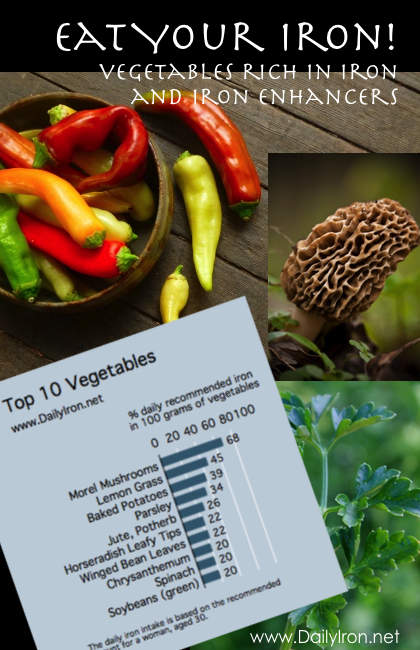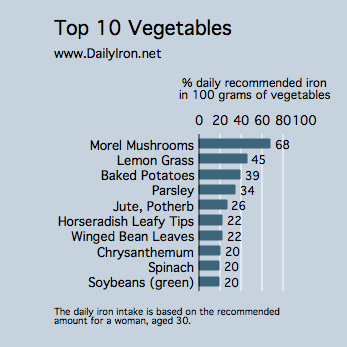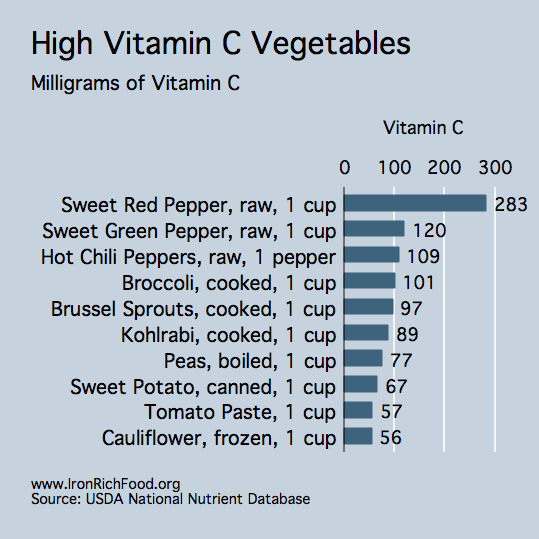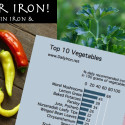 Based on data from the USDA on the nutrient content of food, we found that the top ten vegetables with iron are morel mushrooms, lemon grass, potatoes, parsley, jute, horseradish leafy tips, winged bean leaves, chrysanthemum, spinach, and immature soybeans. The list is based on the iron content of 100 grams of each of those foods. Mushrooms and lemon grass top the list, both of which require a lot of eating to make 100 grams. Neither 100 grams of mushrooms nor lemon grass provide you with 100% of your recommended intake of iron. Vegetables, in general, will add small amounts of iron to your daily intake. If you are a complete vegetarian, your key strategy is to eat a lot of them. Adding an abundance of vegetables to your meals and consuming them without iron inhibitors is your best strategy for increasing the iron rich vegetables in your diet.
Based on data from the USDA on the nutrient content of food, we found that the top ten vegetables with iron are morel mushrooms, lemon grass, potatoes, parsley, jute, horseradish leafy tips, winged bean leaves, chrysanthemum, spinach, and immature soybeans. The list is based on the iron content of 100 grams of each of those foods. Mushrooms and lemon grass top the list, both of which require a lot of eating to make 100 grams. Neither 100 grams of mushrooms nor lemon grass provide you with 100% of your recommended intake of iron. Vegetables, in general, will add small amounts of iron to your daily intake. If you are a complete vegetarian, your key strategy is to eat a lot of them. Adding an abundance of vegetables to your meals and consuming them without iron inhibitors is your best strategy for increasing the iron rich vegetables in your diet.
Iron Inhibitors in Your Vegetables
 One problem with a list of food based solely on the content of a metal is that some foods themselves contain substances that inhibit iron absorption. Spinach is high in oxalic acid which can be cooked off in boiled spinach (discard the water) or in steamed spinach. A wilted spinach salad may be in order if the steam water is allowed to run off. The immature soy beans contain phytic acid which inhibit your iron absorption as well.
One problem with a list of food based solely on the content of a metal is that some foods themselves contain substances that inhibit iron absorption. Spinach is high in oxalic acid which can be cooked off in boiled spinach (discard the water) or in steamed spinach. A wilted spinach salad may be in order if the steam water is allowed to run off. The immature soy beans contain phytic acid which inhibit your iron absorption as well.
Iron Inhibitors Served With Your Vegetables
To make matters worse, if you eat your wilted spinach salad along side a bed of iron-rich amaranth and you have not become familiar with the advice on this site of soaking your amaranth to reduce the phytic acid content, the phytic acid in the amaranth may inhibit your absorption of some of the iron in the wilted spinach salad.
 Vegetables as a class are generally a poor source of iron. Vegetables do not tend to have high levels of iron to begin with and if you eat them with iron inhibitors, you are likely to get very little iron out of your vegetable dish. The book Iron Rich Foods goes into detail on the foods that inhibit your iron absorption, but as another example, drink a cup of black tea with that wilted spinach salad and you will be inhibiting your iron absorption yet again. However, having a high vitamin C food with those vegetables will help.
Vegetables as a class are generally a poor source of iron. Vegetables do not tend to have high levels of iron to begin with and if you eat them with iron inhibitors, you are likely to get very little iron out of your vegetable dish. The book Iron Rich Foods goes into detail on the foods that inhibit your iron absorption, but as another example, drink a cup of black tea with that wilted spinach salad and you will be inhibiting your iron absorption yet again. However, having a high vitamin C food with those vegetables will help.
If you are counting on vegetables to provide you with iron, it is more important than ever to reduce iron inhibitors and increase the vitamin C in your diet. To get the most out of your vegetables, do not eat them with grains, legumes, nuts, and seeds unless you follow kitchen preparation techniques to reduce the phytic acid in your food. You can soak or ferment your grains, for instance, to reduce the phytic acid and improve your iron absorption. Do not consume milk, tea, coffee, or red wine with the meal either.
Common Vegetables And Their Iron Content
Again, there really are few iron rich vegetables, but if you are interested in the iron content of the most commonly consumed vegetables, search our foods database or review the foods in the links below.
|
Read more about iron rich foods.
